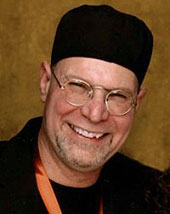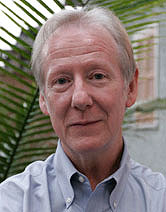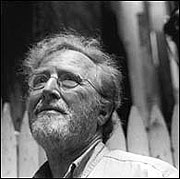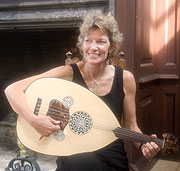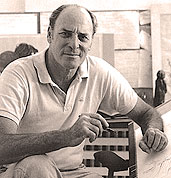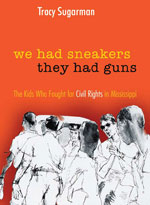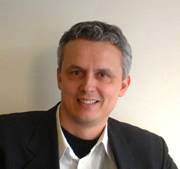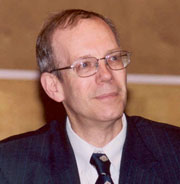| |
|||
|
2009 Botkin LecturesOnline Archive of Past Benjamin A. Botkin Folklife Lectures All of the materials from the Botkin Lectures are available to visitors in the Folklife Reading Room. Selected materials will be made available online as digital versions become available. Scroll down to see available webcasts and event flyer essays for the 2009 season.
December 1, 2009, noon to 1:00 pm“If It Wasn't for the Irish and the Jews: Irish and Jewish Influences on the Music of Vaudeville and Tin Pan Alley,” presented by Mick Moloney, Global Distinguished Professor of Music, New York University View the webcast of this presentation Running time 1:13:52 Mick Moloney's illustrated talk on Jewish and Irish collaborations in vaudeville and early Tin Pan Alley explores a fascinating, though largely forgotten, era in American popular culture. In vaudeville's heyday between 1880 and 1920, Irish/Jewish collaborations on stage were commonplace. They were attended by all sorts of interesting identity ambiguities. For example, the famous Norah Bayes, who had a huge hit with the Ziegfeld Follies with "Has Anybody Here Seen Kelly," was actually Norah Goldberg; she changed her name partly to appeal to the huge Irish-American urban audience. One of her five husbands was Jack Norworth, who wrote "Shine on Harvest Moon" with Norah, and also the huge hit "Take Me Out to the Ball Game." He also wrote many Irish songs. William Jerome and Jean Schwartz were one of the most famous songwriting duos in early Tin Pan Alley. They wrote "My Irish Molly O" which ended up being a number one hit in Ireland in the 1980s, and they also wrote "If It Wasn't for the Irish and the Jews," which was recorded by the legendary Billy Murray in 1912 and became a nationwide hit. Jerome was actually William Flannery from County Tipperary, but changed his name when he saw the songwriting business switching from Irish to Jewish. Dubin, O'Brien and Cormack wrote "'Twas Only an Irishman's Dream," one of the big favorites of early 20th century American tenors. The term Tin Pan Alley was actually invented by a Jewish songwriter named Monroe Rosenfeld, who wrote several Irish songs including "I'll Paralyze the Man who Says McGinty," a parody of the 1890s hit song "Down Went McGinty," written by Irish American songwriter Joseph Flynn. The list goes on and on. And, of course, there was George M Cohan. He was Irish-American, but many people thought he was Jewish because of his name. His story culminated in an absolutely amazing American success story which saw the 'Keohane' family move from destitute famine immigrants to center stage glory and riches on the Great White Way. Mick Moloney's presentation, rich with biographical details and period and contemporary recordings, is a charming story of decades of good natured inter-ethnic flux, competition and cooperation which left a lasting imprint on the history of American popular music. Mick Moloney is an internationally renowned performer and scholar in the field of Irish traditional music. He has recorded and produced over forty albums of traditional music, and acted as advisor for scores of festivals and concerts all over America. Mick also served as the artistic director for several major arts tours including The Green Fields of America, an NCTA-sponsored ensemble of Irish musicians, singers and dancers which toured across the United States. Mick is the author of Far From the Shamrock Shore: The story of Irish American History Through Song, released by Crown Publications in February of 2002 with an accompanying CD on Shanachie Records. He has hosted three nationally syndicated series of folk music on American Public Television; was a consultant, performer and interviewee on the Irish Television special Bringing It All Back Home; a participant, consultant and music arranger of the PBS documentary film Out of Ireland; and a performer on the PBS special The Irish in America: Long Journey Home. In 1999, he was awarded a National Heritage Fellowship from the National Endowment for the Arts — the highest official honor a traditional artist can receive in the United States. Mick holds a Ph.D. in folklore and folklife from the University of Pennsylvania. He has taught ethnomusicology, folklore and Irish studies courses at the University of Pennsylvania, Georgetown, and Villanova Universities, and currently teaches at New York University in the Irish Studies program. For more information, go to the Mick Moloney
October 14, 2009, 12:00 noon - 1:00 pmHear, O Israel: Yiddish-American Radio 1925-1955, presented by Henry Sapoznik, University of Wisconsin. View the webcast of this presentation Running time 0:57:26 While all other aspects of Yiddish culture existed wherever Ashkenazic Jews lived, it was only in America that radio realized its greatest and most fulfilling use by and for Jews. Yiddish scholar Henry Sapoznik discusses and shares some of the most memorable and powerful moments in this nearly lost world of ethnic American broadcasting. By exploring amazingly broad category of Yiddish radio shows — from rabbinical advice programs to live Yiddish theater acts, from man-on-the-street interviews to the news of the day in verse — we encounter a vibrant and vital Jewish-American popular culture at its creative apex and on the eve of its terrible devastation. Henry Sapoznik is a record producer with four Grammy nominations, a radio documentarian, an author, and a performer of traditional Yiddish and American music. He received a 2002 Peabody award for his ten-week National Public Radio series on the history of Jewish broadcasting, The Yiddish Radio Project, the 2000 ASCAP Deems Taylor Award for Music Scholarship for his book Klezmer! Jewish Music from Old World to Our World, and an Emmy nomination for his score to the documentary film, The Life and Times of Hank Greenberg. He founded the Max and Frieda Weinstein Archives of Recorded Sound at the YIVO Institute for Jewish Research, as well as Living Traditions' annual KlezKamp: The Yiddish Folk Arts Program.
September 23, 2009, 12:00 noon - 1:00 pmBuilt with Faith: Place Making and the Religious Imagination in Italian New York, presented by Joseph Sciorra, Queens University, City University of New York. Read the flyer essayView the webcast of this presentation Running time 0:57:47 This presentation examines how Italian Americans create and use vernacular architecture, material culture, and ceremonial display to inscribe meaning on New York City's religious and cultural landscapes. Yard shrines, sidewalk altars, Christmas displays, and other creative productions transform everyday urban space into unique, communal sites of religiosity. Sciorra is especially interested in how people remember, imagine, and interpret the city, as well as people's relationships to the divine at these sites during times of changing, global forces such as de/post-industrialization, suburbanization, migration, and gentrification. Joseph Sciorra is the associate director at Queens College's John D. Calandra Italian American Institute. As a folklorist he has published extensively on religious practices and vernacular spaces in New York City. He is co-editor of the late Sicilian-American poet Vincenzo Ancona's bilingual anthology Malidittu la lingua/Damned Language (Legas, 1990), and the author of R.I.P.: Memorial Wall Art (Thames & Hudson, 1994, 2002) ,a collection of photographs documenting memorial graffiti. In 2003, Dr. Sciorra curated the exhibitions "Sacred Emblems, Community Signs: Historic Flags and Religious Banners from Italian Williamsburg, Brooklyn" and "'Evviva La Madonna Nera!': Italian-American Devotion to the Black Madonna." He successfully nominated the Our Lady of Mt. Carmel Grotto on Staten Island and the Lisanti Chapel in the Bronx to the National and New York State Registers of Historical Places
August 13, 2009, 12:00 noon - 1:00 pmDocumenting Katrina and Rita in Houston, presented by Carl Lindahl, University of Houston and Pat Jasper, Austin, Texas. View the webcast of this presentation Running time 1:10:04 Surviving Katrina and Rita in Houston is the first large-scale project, anywhere, in which the survivors of a major disaster have taken the lead in documenting it. The project's goal is to voice, as intimately as possible, the experiences and reflections of those displaced to Houston by the two major hurricanes that pounded the Gulf Coast in August and September of 2005. The heart of the project is stories: stories told by survivors, to survivors, on the survivors' own terms. Project co-directors Carl Lindahl and Pat Jasper hear in these narratives the seeds of recovery: it is the conviction of the project and its many participants that to survive is not merely to secure food, clothing, and the essentials o daily life, but also to help shape one's future by taking control of one's own story. While media treatments of the survivors have too often depicted criminals or, at best, victims, the voices of the survivors themselves have portrayed selfless friends, compassionate strangers, loving neighbors, and, above all, heroes. Carl Lindahl and Pat Jasper will describe the genesis of the project and the field school that they developed in conjunction with the American Folklife Center to train survivors. They will discuss current research on the 432 interviews conducted to date, and describe public programming that has brought the survivors into contact with their new neighbors in Houston through panel discussions, radio broadcasts, museum installations, and musical events. An online exhibit in photographs and sound recordings has been made available by the Houston Institute for Culture: Voices of Hurricane Katrina Survivors from the Surviving Katrina and Rita in Houston Project.
June 11, 2009, 12:00 noon - 1:00 pmThe High Lonesome Sound Revisited: Documenting Traditional Culture in America, Presented by filmmaker John Cohen View the webcast of this presentation Running time 1:01:27 In the early 1960s, the multitalented musician, filmmaker, and photographer John Cohen journeyed to eastern Kentucky to document the songs of church-goers, miners, and farmers, and the rural community that produced and sustained their uniquely American sound. The result was The High Lonesome Sound, a classic 1963 documentary film than evocatively illustrates how music and religion help Appalachian people maintain their dignity and traditions in the face of change and hardship. Featuring master traditional musician Roscoe Holcomb, Cohen's film also documented how different musical strands are synthesized in the playing of an individual performer. In this presentation, Cohen will discuss the making of his influential documentary, its initial reception, and its continued impact in the shaping of documentary filmmaking and ethnographic research on traditional culture both in the United States and abroad. A respected musician and founding member of the seminal old-time string band "The New Lost City Ramblers," John Cohen has also had an equally distinguished career as a filmmaker, photographer, and record producer. The term "high lonesome sound," which he coined for his legendary 1963 documentary film, has become synonymous with an entire genre of American music. In addition to extensive fieldwork and documentation of Appalachian culture, Cohen has done important ethnographic research throughout the United States, Britain, and the Peruvian Andes. His highly-praised publication, There Is No Eye: John Cohen Photographs (2001), and the complementary Smithsonian Folkways CD There Is No Eye: Music For Photographs, brought together several threads of Cohen's work over the past fifty years. As a producer, his many noteworthy recordings include Smithsonian Folkways' releases An Untamed Sense of Control by Roscoe Holcomb), Dark Holler by Dillard Chandler, The Lost Recordings of Banjo Bill Cornett, If I Had My Way by Rev. Gary Davis, and the compilation Back Roads to Cold Mountain. Cohen worked with T-Bone Burnett as music consultant to the film "Cold Mountain," and appeared in Martin Scorcese's film about Bob Dylan, No Direction Home.
May 13, 2009, 12:00 noon - 1:00 pmThe Sound of Islamic Music: Women's Voices and the Indonesian Religious Soundscape, presented by Anne K. Rasmussen, Associate Professor of Music and Ethnomusicology, College of William and Mary. Webcast forthcoming Based on more than two years of ethnographic research in the Indonesian Archipelago, and derived from her book Women's Voices, the Recited Qur'an, and Islamic Music in Indonesia (University of California Press), Anne Rasmussen's lecture introduces a rich world of Indonesian Islamic music. She includes sound and video clips, and profiles both leading artists and grass-roots communities. Her attention to the actions of women who work as ritual specialists and religious artists — from Qur'an reciters to recording artists — brings to light a little-documented but very dynamic area of both Indonesian culture and Islamic performance. Anne K. Rasmussen is associate professor of music and ethnomusicology at The College of William and Mary in Williamsburg, Virginia where she also directs the William and Mary Middle Eastern Music Ensemble and serves as chair of the Middle East Studies Faculty. In September 2008, she was appointed University Professor for Teaching Excellence. Her research and teaching expertise include American musical multiculturalism, music and community among the Arab diaspora, music-cultures of the Middle East and the Arab world, and music of the Islamic world, particularly Indonesia, where she has been engaged for the last ten years in a project on Islamic musical arts. She is a former Fulbright senior scholar and has served as the First Vice President of the Society for Ethnomusicology. She is the recipient of the Jaap Kunst prize for the best article published in the field of ethnomusicology in 2001, and the Phi Beta Kappa Teaching Award.
Tuesday, May 5, 2009, 12:00 noon - 1:00 pmWe Had Sneakers, They Had Guns: The Kids Who Fought for Civil Rights in Mississippi lecture and book signing presented by Tracy Sugarman View the webcast of this presentation Running time 0:54:48 As an illustrator and journalist, Tracy Sugarman covered the nearly one thousand student volunteers who traveled to the Mississippi Delta to assist black citizens in the South in registering to vote. Two white students and one black student were slain in the struggle, many were beaten and hundreds arrested, and churches and homes were burned to the ground by the opponents of equality. Yet the example of Freedom Summer resonated across the nation. The United States Congress was finally moved to pass the civil rights legislation that enfranchised millions of black Americans.
Blending oral history with memoir, We Had Sneakers, They Had Guns chronicles the sacrifices, tragedies, and triumphs of that unprecedented moment in American history. A book signing will follow the lecture. Tracy Sugarman is a nationally recognized illustrator whose art has appeared in magazines and books, and has been featured on PBS, ABC TV, NBC TV, and CBS TV. His collection of art from World War II has been acquired by the Veterans History Project, a program of the American Folklife Center at the Library of Congress. He is the author of Stranger at the Gates: A Summer in Mississippi, My War: A Love Story in Letters and Drawings, and Drawing Conclusions: An Artist Discovers His America.
April 30, 2009, 12:00 noon - 1:00 pmWarning of Global Warming? Shamanic Tradition, Politics and Ecological Change in Siberia, presented by Marjorie Mandelstam Balzer, Georgetown University Webcast forthcoming Siberian indigenous peoples' striving for self-determination and spiritual vitality has been an impressive trend in the past twenty years, but their efforts are threatened by political, social and ecological change. This talk, based on long-term fieldwork in the Sakha Republic (Yakutia) and beyond, probes the implications of indigenous peoples' concerns. The focus is on the Sakha (Yakut), who are the farthest north of the Turkic language speakers, and the majority indigenous group of their multiethnic republic in the Far East of the Russian Federation. Since the Soviet Union collapsed, they have been coping with the tensions of increased development, mixed-signal federal policies, and valiant attempts at cultural revitalization. In summer 2007, a close Sakha colleague, Uliana Vinokurova, sociologist and former deputy in the Sakha Republic's parliament, shared her concern about climate change reaching the Far North region where she grew up. Not only had their villages seen more numerous and serious floods in the past decade, she explained, "the folk wisdom of our elders does not seem to predict our climate the way it used to." People were worrying about the broader encompassing health, ecology and social problems that fluctuations seem to bring, and whether rituals of cultural and ecological renewal could stem the tide. How far do the ripple effects of climate change go? How do indigenous land keepers discuss the dangers and potential remedies of change? Are indigenous Siberians who rely on subsistence the "canaries in the mine" — warning of global warming?
March 24, 2009, 12:00 noon - 1:00 pmLiving and Building between Tradition and Change: Vernacular Architecture in Northern Sweden, Mats Widbom, Cultural Counselor, Embassy of Sweden View the webcast of this presentation Running time 0:58:00 Architect and folklorist Mats Widbom will present his research on the traditional building culture of Dalecarlia in Northern Sweden. In particular, he will explore how the parstuga (double house) has been used and rebuilt over time in the parish of Lima. His research demonstrates that traditional culture, as expressed in architecture, is not something permanent; it need not have a particular appearance and derivation from the past. Rather, he contends, tradition is something that is constantly being reinterpreted and re-created in the present, in dynamic oscillation between continuity and change. Mats Widbom, Cultural Counselor, came to the Embassy of Sweden in September 2006, from the governmental authority Swedish Travelling Exhibitions, where he served as Head of Exhibitions, Acting Director General, and Artistic Director. He holds a Master's Degree in Architecture from the Royal Institute of Technology in Stockholm, and has also studied at the legendary Institute for Architecture and Urban Studies in New York. He produced and was the project leader for the successful exhibition "Swedish Folk Art – All Tradition is Change," which toured for over four years throughout the United States and Canada. From 1998 to 2004, he was President of the Swedish National Committee of the International Council of Museums (ICOM) and a board member of the International Committee for Exhibitions and Exchange (ICEE) 2001-2006.
January 27, 2009, 12:00 noon - 1:00 pmRevolutionaries, Nursery Rhymes, and Edison Wax Cylinders: The Remarkable Tale of the Earliest Korean Sound Recordings, presented by Robert Provine, University of Maryland. View the webcast of this presentation Running time 00:59:33 On July 24, 1896, the pioneering ethnologist Alice Fletcher recorded six wax cylinders documenting the singing of three Koreans who were studying in Washington, D.C. Now housed in the American Folklife Center Archive, these cylinders have proved to be the earliest known recordings of Korean music. As interesting as the recordings themselves, are the extraordinary circumstances surrounding how they came to be made, as well as the remarkable group of people, both Korean and American, who were involved in this landmark project. This richly illustrated lecture explores the historical circumstances and the musical significance of these remarkable and remarkably early wax cylinders. Ethnomusicologist Robert Provine is a Professor at the University of Maryland's School of Music. From 1978 until 2000, he was Professor of Music at the University of Durham in the U.K. A past President of the Association for Korean Studies in Europe, he is author of Essays on Sino-Korean Musicology: Early Sources for Korean Ritual Music (1988), as well as numerous articles on Korean traditional music. |
| ||||


